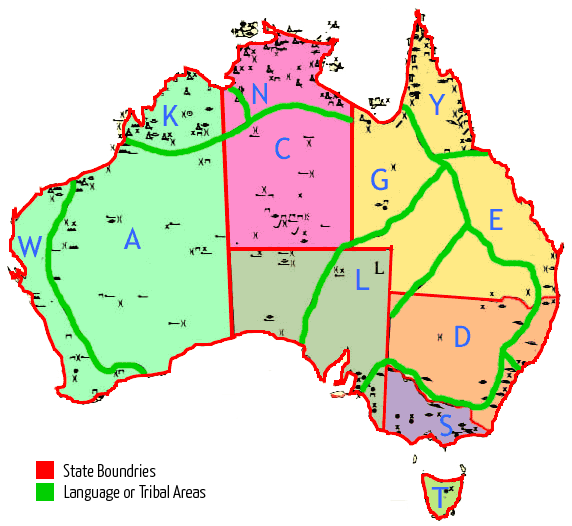Aboriginal Music Instruments
Different tribes used various instruments including boomerangs, clubs, sticks, hollow logs, drums, seed rattles and of course the didgeridoo. Hand clapping and lap/thigh slapping were common. Decorated drums were made from hollow logs and some covered with reptile skins. Large conch shells were used in the northern coastal areas. The best known of all Aboriginal musical instruments was the didgeridoo and we explore this instrument in depth in another section.

Over a large area of Australia, Aboriginal music has consisted (in
many places still consists), a group singing accompanied by different
kinds of idiophonic percussion. In north Queensland (area 'Y')
accompaniments may consist of hand clapping only; for songs of intrusive
types, such as 'island style' songs, a skin drum may be added.
On Bathurst and Melville Islands, off the north-west coast of area
'N', songs types of different
kinds are accompanied by hand clapping, buttocks-slapping, or by
paired sticks. In a small area of Western Australia (north area
'W' and south of area 'K')
one type of non-dance song (Djabi or Taabi) is accompanied by a
scraped idiophone, or rasp. North of the Northern Territory, in
area 'N', where is considerable
diversity in song types and sound instruments, some songs are accompanied
only by stick percussion (either paired hand sticks or paired boomerang
clapsticks, depending on content and ceremonial association), others
are performed by voice, sticks and didjeridu.
According to information obtained from written sources and available
audio-recordings, there are about thirty Australian sound instruments,
or agents for producing different sounds. About 75 per cent of these
occur above 20 latitude and above a line joining Broome, southwest
of 'K', to Ingham, southeast
of 'Y'. About 50 per cent occur
below this line. No attempt has been made as yet to reconstruct
a relative chronology for Australian Aboriginal sound instruments;
nor for the song types with which particular instruments are formally
integrated.
Patterns of geographical distribution at least offer a starting
point. Didjeridu-accompanied songs stand out clearly against a background
of songs accompanied only by percussion; and the musical participation
of a aerophone, within an ensemble where voice and percussion are
paramount, would seem to be evidence enough for its 'superimposition',
or intrusion into an older musical situation already widely established.
Distribution of Aboriginal Sound Instruments
* Bark or skin bundle beaten, or struck on ground (women)
* Bone or reed whistle
* Boomerang clapsticks
* Didgeridoo and sticks (beaten by singer)
* Folded leaf whistle
* Hand clapping
* Hollow log struck with small stick
* Llpirra or Central Australian "trumpet"
* Lap slapping (women)
* Rasp or friction
* Seed rattles
* Single head skin drum (struck with open palm or stick)
* Stick beaten on ground
* Sticks only
* Thigh slapping (men)
